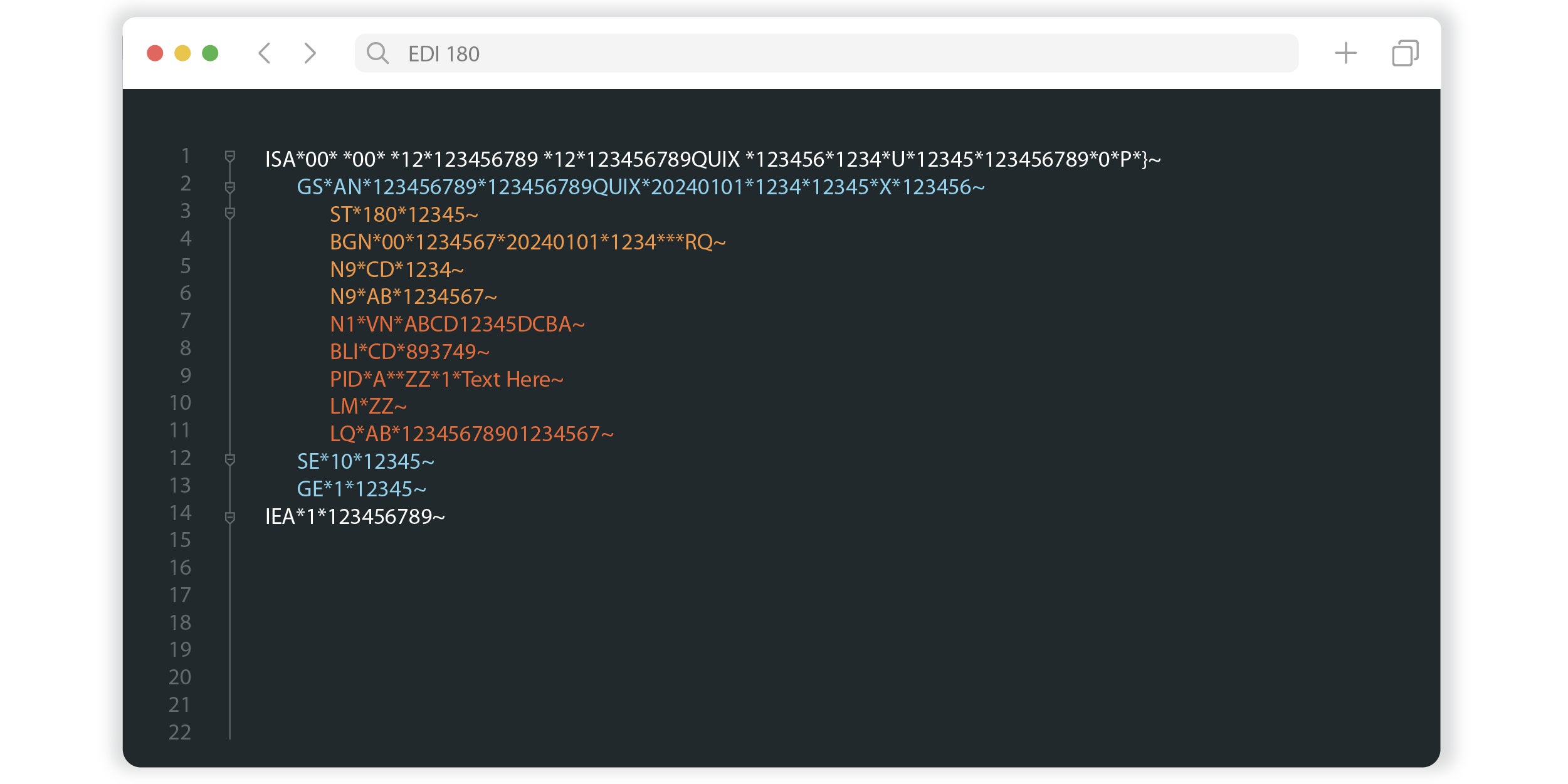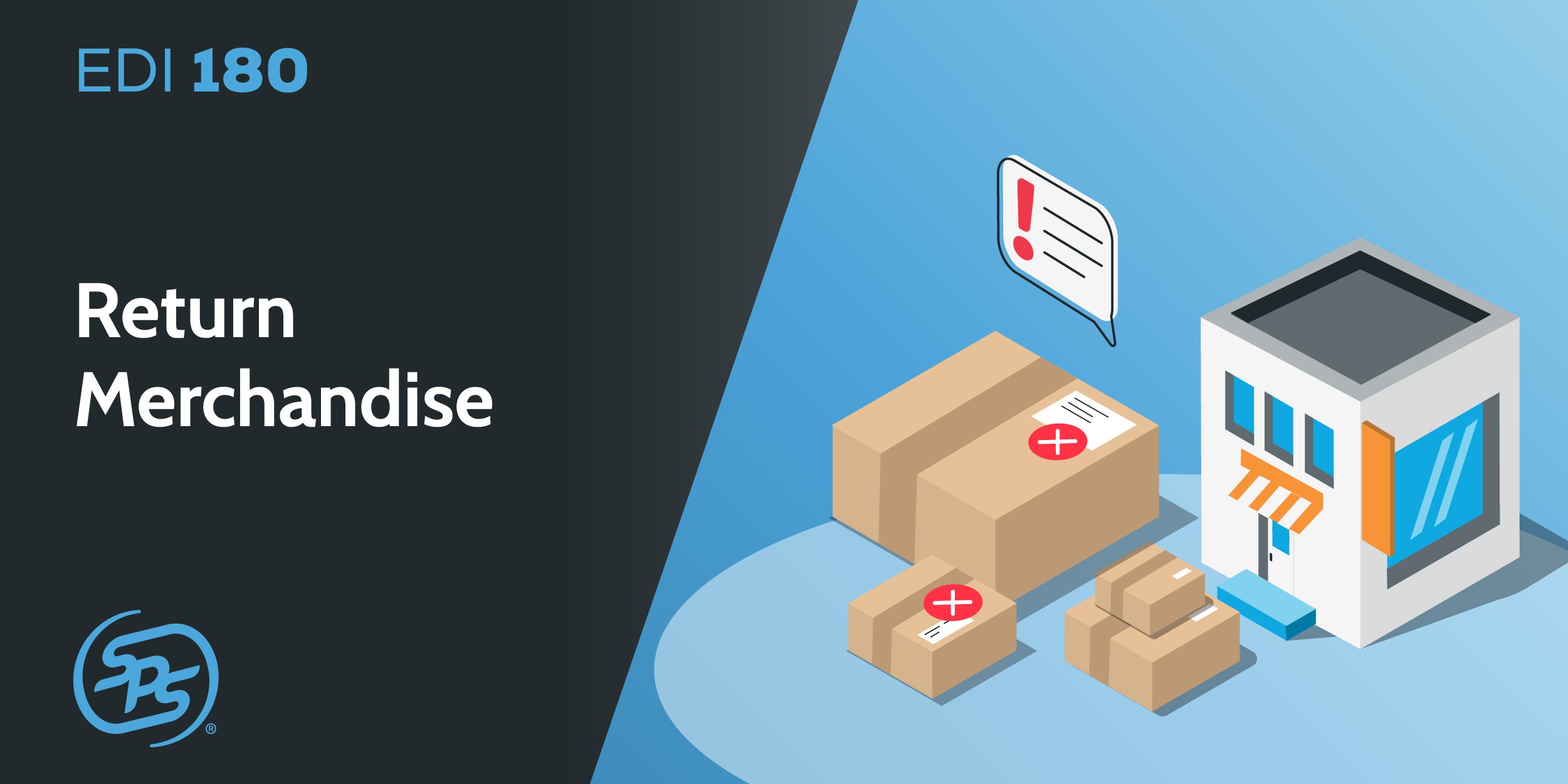EDI 180 format
This transaction set can include details such as requests for returns, shipping information, return notifications, notifications of consumer returns and authorization of returns. It’s designed to facilitate the return process, improve inventory accuracy and enhance the efficiency of communication between trading partners.

Here’s a brief overview of the format based on the X12 Transaction Set specifications:
Beginning section
- ISA: Interchange control header
- GS: Functional group header
- ST: Transaction set header
- BGN: Beginning segment
Details section
- RDR: Return discrepancy reason
- PRF: Purchase order reference
- SAC: Service, promotion, allowance or charge information (used multiple times for various charges or allowances)
Carrier & code section
- TD1: Carrier details (quantity and weight)
- LM: Code source information
- LQ: Industry code
Closing section
- SE: Transaction set trailer
- GE: Functional group trailer
- IEA: Interchange control trailer
How is the EDI 180 used?
The EDI 180 document is primarily used for:
Requesting and authorizing returns:
Retailers or buyers send an EDI 180 to suppliers to request permission to return merchandise. It includes reasons for the return, such as item defects or incorrect shipments.
Notification of returns:
It serves as a notification to suppliers that merchandise is being returned. This can be initiated by the buyer or in response to a supplier’s authorization.
Communication of return instructions:
The EDI 180 can include instructions for the return, including how and where to send the merchandise back.
Documentation:
It provides a formal record of the communication and authorization process related to returns.
Benefits of using an an EDI 180 Return Merchandise Authorization
The implementation of EDI 180 benefits the supply chain in several ways, including:
Efficiency:
Visibility:
Inventory management:
Cost reduction:
Customer satisfaction:
Compliance:
Common issues regarding EDI 180
Human errors and missing fields
Do you encounter incomplete data that prevents or delays the quotation process from moving forward?
Older format issues
Some older formats of EDI (EDIFACT or IMP) were not created for humans to read and understand them, therefore catching and fixing errors can be challenging.
Automate EDI 180 with Full-Service EDI from SPS Commerce

Managing ongoing EDI tasks can be complex and time-consuming. SPS communicates directly with your trading partners to manage connectivity, setup, requirements, updates and support efforts. SPS also takes ownership of understanding your trading partner requirements and making map changes.
Full-service EDI providers like SPS Commerce deliver EDI technology and associated staffing resources responsible for customizing, optimizing and operating your EDI solution. SPS communicates directly with your trading partners to manage connectivity, setup, requirements, updates and support efforts. SPS also takes ownership of understanding your trading partner requirements and making map changes.
A full-service provider, like SPS Commerce, has an expert team that handles ongoing management of your EDI solution. The SPS team actively manages 9,000 changes from retailers each year. SPS Fulfillment proactively monitors and optimizes your solution to prevent errors and minimize data entry.
Interested in learning more about our EDI solution?
Additional EDI Resources
Enter a virtual library of information about EDI for suppliers, vendors and distributors to provide you with the product knowledge you need to power your business.
Ultimate List of EDI Transactions
Here are some of the most common documents and transactions that are supported through EDI automation.
Five Top EDI Documents to Automate
When you automate your most-used EDI documents, it can significantly cut down keystrokes and speed up processes.
EDI Glossary
Terminology including retail definitions, order management models, supply chain roles, software and distribution channels.
EDI for Suppliers & Vendors
Discover how leading vendor and supplier businesses are serving their customers better with EDI solutions from SPS Commerce.




